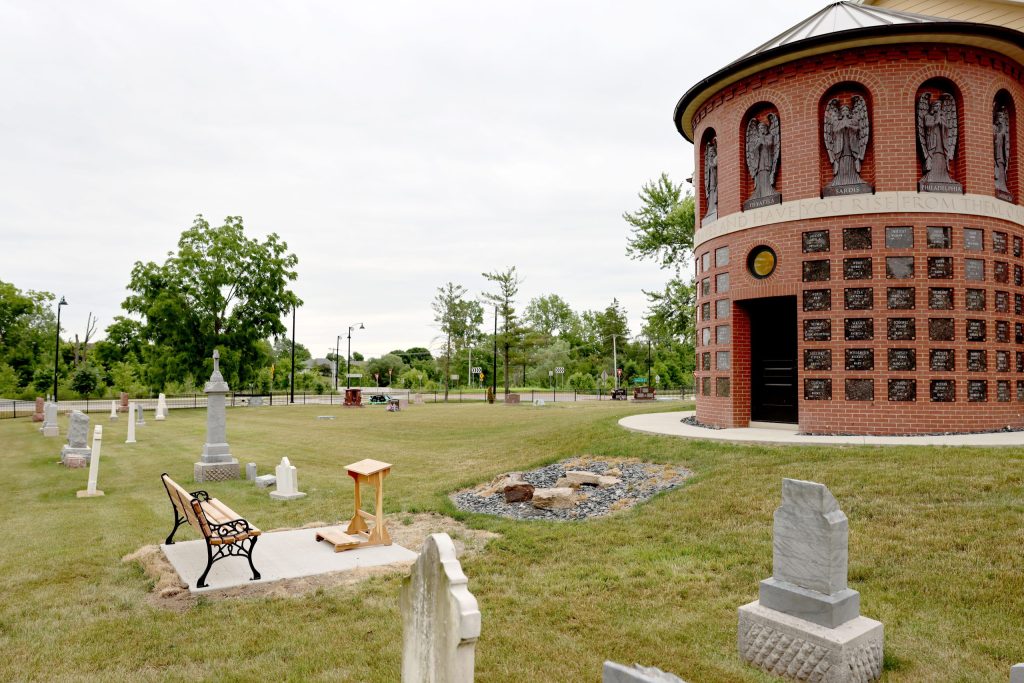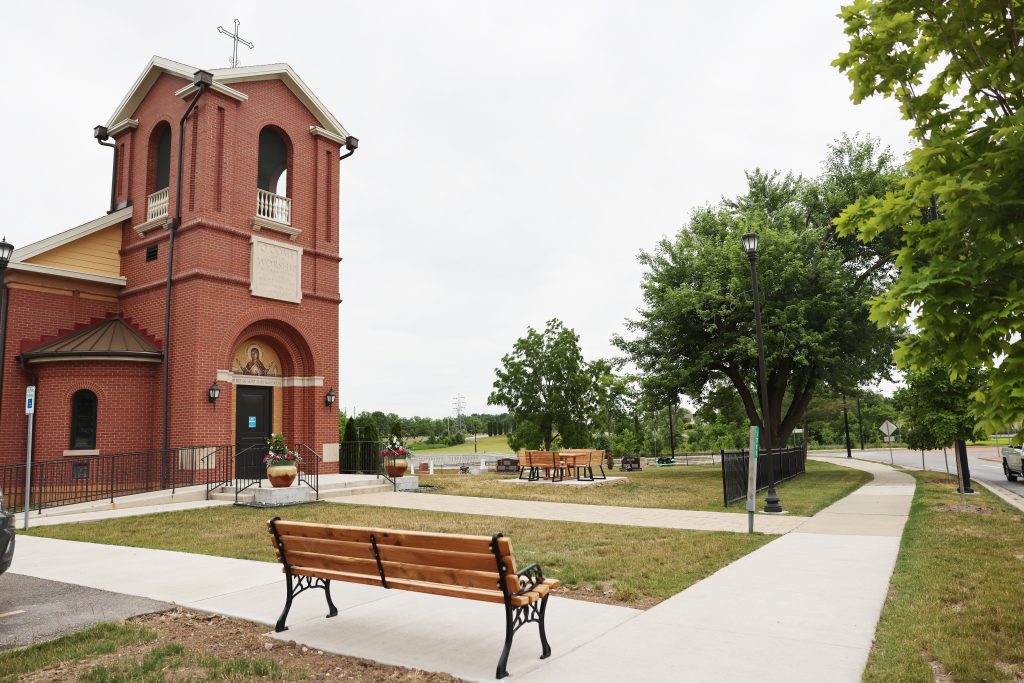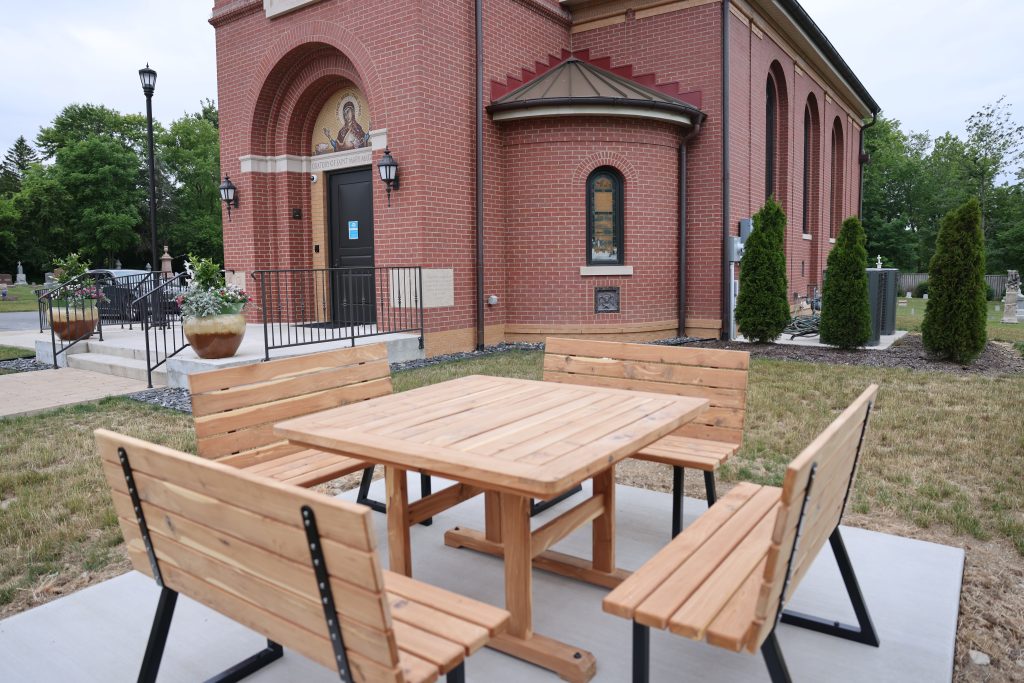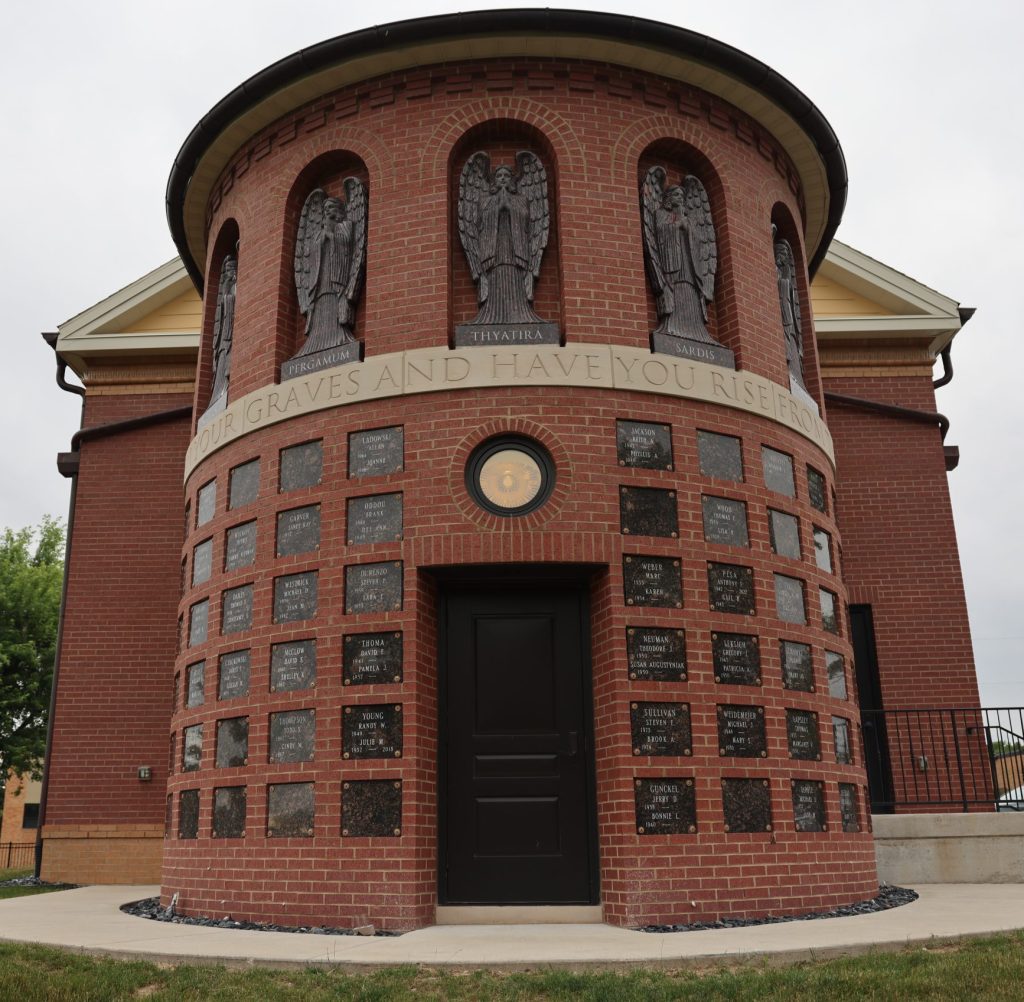July 10, 2023 // Diocese
Trees that Died are Made New Again Outside the Oratory of St. Mary Magdalene
When visitors enter the Oratory of St. Mary Magdalene in Fort Wayne, among the many beautiful and striking sights before them, they will see engraved beneath the Cross of Christ, “Behold, I make all things new.” These words from the Book of Revelation encapsulate the entire story of salvation while also describing the spiritual work which takes place in the Oratory, as the Lord continually “makes new” those who offer their time and their hearts to Him in His Eucharistic presence.
In a unique way, the outside of the Oratory has now been made new as well.

Photos by Christopher Lushis
Some of the trees have been repurposed to create a bench and kneeler for visitors to pray for and remember loved ones buried there. It is also strategically placed for people to view and adore the Blessed Sacrament through the clear window directly behind the monstrance from the outside.
The Oratory, a perpetual Eucharistic adoration chapel which stands across the street from St. Vincent de Paul Church and School in Fort Wayne, opened in the fall of 2020. It was built upon the site of a previous St. Vincent’s Church building constructed in 1904. Like many churches of years past, the parish site maintained a cemetery nearby to bury its deceased parishioners. When the Oratory was later built on this site, additional land was cleared on the east side to make room for new burial plots. Creating this space required cutting down some large cedar trees that were replaced by younger ones along the sidewalk.
Now, more than two years later, these cedar trees have returned, albeit in new forms. Previously, their existence testified to the stability and strength of God, as nature always reflects characteristics of its Creator. In the spirit of re-creation and renewal, the wood from these trees has been fashioned into benches, a kneeler, a table, and chairs that surround the outside of the Oratory to aid visiting pilgrims.

Large cedar trees that were cut down to create space for more burial plots on the site of the Oratory of St. Mary Magdelene in Fort Wayne are repurposed to create a table and chairs for visitors to sit and remember loved ones buried there.
While the walls of the Oratory are lined with beautiful stained-glass windows of saints from both medieval and modern times, the window directly behind the monstrance remains clear and visible from the outside. This provides visitors to the cemetery an opportunity to view and adore the Blessed Sacrament from the grass. Now, thanks to the repurposing of the Oratory trees, those seeking an outdoor adoration experience have a kneeler and bench to assist their prayer.
Some travel to the cemetery to visit relatives and friends buried there, to pray for their souls, and to remember fond memories with them. The benches and table provide a new space to sit, ponder, and pray in the stillness, broken up only by the hum of passing cars in the background.
St. Vincent’s parishioner Alyssa Torres remarked, “When something dies, like when we have to cut down a tree, for example, we would think it’s dead now and not alive anymore. But God uses things that die to bring forth something new. Jesus says, ‘Unless a grain of wheat falls to the ground and dies it is just a grain of wheat, but if it dies, it produces much fruit.’ That is the same story for these trees. They have a new life, their own resurrection, being changed from something that appears to be dead into something that is going to give new life.”
When considering the journey of these trees, one is reminded of the children’s story “The Tale of Three Trees,” which chronicles the desire of three mighty trees to do something heroic. To their dismay, they are cut down and used in underwhelming and menial ways, leading them to think that their dreams of glory will never be achieved. However, when they later become the source of Christ’s wooden manger, the apostles’ ship on the Sea of Galilee, and the Cross at Calvary, each realizes they had been prepared for something greater than imaginable all along. Their experience of transformation and transfiguration serve a new loftier purpose in the plan of God to bring about His kingdom. One could say the same has also happened for these trees in Fort Wayne. The mighty cedars which once provided shade over the deceased now support and sustain the living in their journey of faith.
These were also not the first trees repurposed at the Oratory or with significant meaning behind them. Shortly after it was opened, St. Vincent’s Pastor, Father Daniel Scheidt revealed a family connection to the unique “Tree of Life” Cross hanging above the sanctuary. A familiar sight on nearly every crucifix is the titulus indicating Pontius Pilate’s sentence of our Lord: “Jesus of Nazareth, King of the Jews,” (usually abbreviated “INRI” corresponding to the Latin initials). Father Scheidt shared that the titulus at the Oratory was made of wood from an apple tree which previously stood outside his grandfather’s home. This seems a fitting addition for a chapel that displays an abundance of apples blossoming forth from the Tree of Life, now made accessible to humanity through Christ’s death and resurrection. He remarked, “This Oratory exists for all things to be made new.”
Furthermore, each stained-glass window in the Oratory contains one of the trees mentioned in the Song of Songs. Father Scheidt described these details in a homily given at the Oratory, explaining, “For the early years of Jesus’ life, [pointing to the back-left window] an almond tree, when Jesus was no larger than an almond. The middle window has a fig tree, which Jesus alludes to in His public ministry before His passion. The front left has a myrrh tree, flanked on the front right by a frankincense tree; so, [pointing to the gold monstrance] we have the gifts the wise men brought to adore Jesus. The central-right window has a palm tree, which lays the groundwork for Jesus’ triumphal entry into Jerusalem. The back-right window has a pomegranate tree, which when it is ripe bursts open to release its seeds just as the tomb bursts open with the Risen Lord. The two paintings on the back walls have olive trees, reflecting the Garden of Gethsemane, which means ‘olive press.’ Of course, the apple tree (the Tree of Life) is in the center. The whole decorative motif is meant to reveal that we are invited into paradise. This is an image of Creation in its origin, but also Creation in its fulfillment.”
He also emphasized that the Oratory is meant to be “a refuge we can come to no matter what the troubles of our life or the troubles of our world. It is a participation in the Church, continually, uninterruptedly, at prayer. We participate in the adoration that is joined by the angels and saints, we adore God Himself and from that mystery we have what we need to bear the crosses in the present moment, to bear our witness, to know that we are instruments in the hand of God, who makes all things new.”
The best news. Delivered to your inbox.
Subscribe to our mailing list today.








